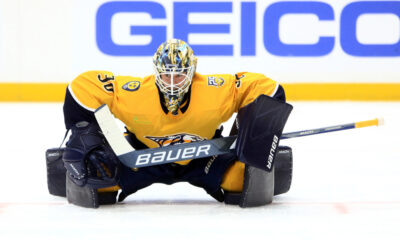It’s one of the most routine procedures in any NHL game.
Two opponents enter the face-off circle, meeting at the center dot. A linesman comes between them and, after a brief pause, drops the puck in play.
But this year, as experienced hockey spectators have noticed, face-offs seem to be anything but routine.
Watch any NHL game today and you’ll see a number of delays on face-offs because of rule-happy linesmen. At least 5-6 times every game, one player or another is getting kicked out of the center dot for violating a face-off rule.
The NHL does not track data on players getting kicked out of face-offs. So there’s no easy way to compare this phenomenon between seasons.
But according to at least one player on the Nashville Predators, it’s definitely an issue.
“We have a sentiment in here that they’re kicking a lot of guys out [of face-offs],” Michael McCarron tells Penalty Box Radio on Monday. “My biggest thing with [the officials] is they gotta be all on the same page. Different crews, they have different rules.”
McCarron, a seven year veteran on the face-off dot with a career 50.8% win rate, suggests consistency among officiating crews is the main reason we are seeing a high number of face-off violations.
“Like, you’re not allowed to use your feet anymore,” McCarron explains. “but some linesmen let you use your feet. Some don’t make you go straight down as an offensive player. So you can just sweep right through, but others make you go down. So, like in one game, you might be able to come in just swipe from the side, and then the next time you come in you try it, and you’re kicked out. Because that’s not the rule. You have to come down. It just kind of seems like different linesmen have different rules.”
When McCarron describes “using your feet”, he’s talking about the strategy of using your skates to block the other player from successfully drawing the puck back. A recent rule change disallowed the use of feet in the face-off dot, so players can no longer bring their feet in ahead of the drop as a way to block the draw.
But apparently not all linesmen enforce that rule.
“Yeah, you’re not allowed to use your foot in anymore to use it as a block. [Nazem] Kadri did that a lot against us, a couple other guys do it. Some linesmen will kick you out if you try that, because it’s a rule now. But not every time.”
The other issue McCarron described has to do with the attacking player’s approach. For those unfamiliar, the rules are specific about which players must have their stick on the ice first.
Rule 76.4 states “…the sticks of both players facing-off shall have the blade on the ice, within the designated white area. At the eight face-off spots (excluding center ice face-off spot), the defending player shall place his stick within the designated white area first followed immediately by the attacking player. When the face-off is conducted at the center ice face-off spot, the visiting player shall place his stick on the ice first.“
So while it’s clear the defending player must have his stick on the ice first (except at center ice, when it must be the visiting team), the attacking player is only required to have his on the ice “immediately after.” That leaves room for interpretation from officials. Some seem to require the attacking player have their stick on the ice before the puck is dropped. Others seem fine with it being on the ice “as the puck is dropped,” which allows the attacking player to “swipe” at the puck as it’s dropped. This gives them a huge advantage, but it’s been called both ways for a while.
“Some guys will make you come all the way down and set before they drop the puck,” McCarron says. “But others, you don’t even have to set, you can just swipe [at the puck.] That’s what’s throwing everybody for a loop.”
Also, sometimes it’s not even the center’s fault for being kicked out off the dot: a winger can delay the drop by getting too aggressive off the draw.
“They’re a lot more strict on guys encroaching as wingers, too. So they will kick guys out for wingers encroaching. So it just kind of seems like they’re taking the face-offs a lot more seriously.”
You can certainly understand McCarron’s frustration here. Consistency in rules officiating is a common complaint among players (and coaches and fans, etc.) because most penalty calls have an element of subjectivity.
But face-off officiating seems more straight forward. It shouldn’t be that tough to get everyone on the same page, right? Or to modify the rules to make sure any subjectivity is removed?
In the meantime, players like McCarron are feeling the brunt of this new puck drop integrity. McCarron is sitting at 47% success this season, which according to him is “not great.” Colton Sissons, arguably the Preds’ best face-off man, has a career low 50.5% success rate this year, several ticks below his impressive 53.6% career win rate.
So how do players adjust to the new standard?
“You just have to take the first one and see how it goes,” McCarron tells me. “See what the linesman is going to do for that game. Honestly, I mean, it’s the NHL, you get really good linesman. But at the same time, they are different in how they run a face-off. So you’ve just got to see how the first one goes and see what they’re allowing.”
— Featured image via Fred Kfoury III/Icon Sportswire —
This article sponsored by Sallis Realty Group


















